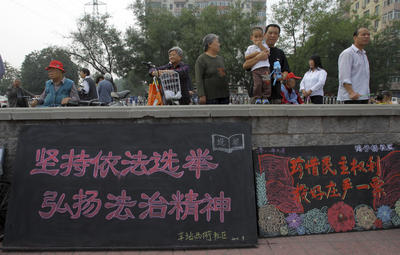Rather, it helps explain why and how the Communist Party continues to rule over China.
Chinese leaders effectively provide an outlet for the most mobilised, informed and engaged segments of the population to express their opinions through selective tolerance of popular protests and policy debates. At the same time, the state relies upon pervasive surveillance, coercion and censorship to restrain activists from mobilising to directly challenge its rule. The result is a kind of contained contention, in which popular protests continue to erupt and influence specific policy decisions but do not fundamentally undermine the party-state’s authority.
In the foreign policy realm, these dynamics are particularly clear in China’s relations with Japan over the past decade. China experienced a swell of negative public opinion towards Japan from 2001, which combined protests and sensationalist media coverage of their eastern neighbour. This situation impeded diplomatic negotiations, interrupted bilateral economic cooperation, spurred belligerent rhetoric and forced Beijing to withdraw a major diplomatic initiative. By 2005, China’s Japan policy was in crisis. Sino-Japanese relations had sunk to their lowest point since diplomatic ties were restored in 1972, while the regime faced a domestic protest movement that threatened to spiral out of control.
Chinese leaders responded by combining propaganda and diplomacy with censorship and repression. The government managed to successfully rein in anti-Japan activism, reshape the domestic information environment and improve public opinion towards Japan over the subsequent years. Sino-Japanese relations returned to relative stability by 2010. Given the strength and persistence of anti-Japanese sentiments among the Chinese public, the Party’s success is particularly impressive.
The Japanese example suggests that rather than acceding to popular nationalist pressures for a more aggressive foreign policy, China’s policymakers have developed an effective strategy for responding to sporadic outbursts of popular anger on foreign policy. Chinese leaders enable the release of public anger and demonstrate a modicum of responsiveness to public opinion by making partial policy shifts or rhetorical gestures in the directions demanded by the public. Such shifts are generally part of a broader strategy of readjusting their overall foreign policy toward an approach that cools public anger, redirects the public’s attention and mitigates any diplomatic fallout that might result from following too closely the dictates of an emotional public. A similar strategy was on display following China’s recent tensions with Southeast Asian states over maritime disputes in the South China Sea.
By combining a diplomatic strategy designed to reshape the external environment with its considerable propaganda power to refocus attention, limit the flow of information, and project selective images to large segments of the public, the Party manages to end spates of public mobilisation without irreparable harm to foreign relations and without leaving behind a mass of dissatisfied, frustrated citizens.
Simply put, the rise of popular nationalism in reform-era China has not correlated with a rise in military aggression. China is unquestionably seeking to assert its interests in the world commensurate with its rapidly growing economic, military and political clout, but the pattern of behaviour hardly reflects that of a foolhardy, overly-aggressive foreign policy.
This approach helps explain how the world’s largest and most powerful communist party, dedicated to constructing a ‘harmonious society’, maintains its authority over a society rife with tension and contention. The common presumption is that popular protests in China reflect regime weakness. Yet rather than revealing the vulnerability of the Chinese Communist Party, popular expressions of emotion on the streets, online and in the media may actually play a role in sustaining Party authority and legitimacy.
Protests provide the leadership with information on relevant aspects of popular sentiments. They also serve as a release valve, directing popular anger away from the Party itself. By responding to public expressions of anger with symbolic or partial policy shifts, Chinese leaders can demonstrate their responsiveness to the people’s concerns, thus alleviating potential criticism from some of the most mobilised segments of society.
Waxing and waning in the Party’s tolerance of social activism has become a defining feature of Communist Party rule in China. The greatest threat to the Party’s prospects for maintaining power is the possibility that Chinese leaders will veer too far in either direction. Failing to sustain a modicum of tolerance, responsiveness and persuasion in the face of social pressure will be as destructive to the Party’s hopes for continued rule as is passive tolerance in the face of widening social protest and political dissent. The prospects for single-party rule in China depend upon the Party’s success in sustaining this delicate balance.
Dr James Reilly is a Lecturer at the University of Sydney and is the author of the forthcoming book Strong Society, Smart State: The Rise of Public Opinion in China’s Japan Policy (Columbia University Press, 2012).

